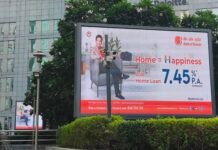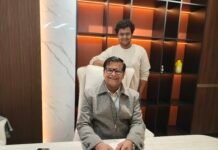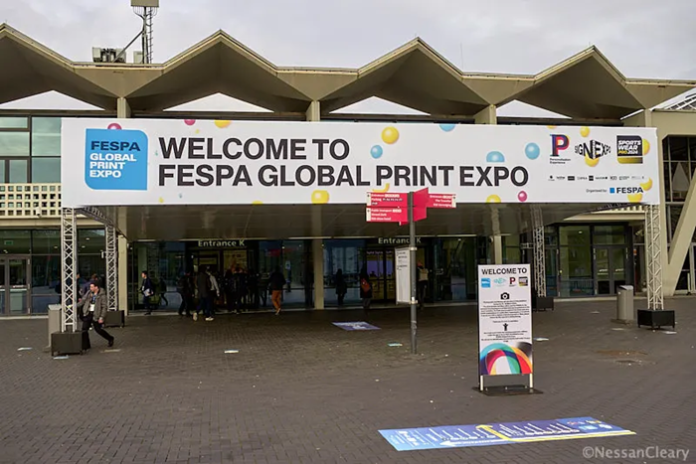
One of the main takeaways for me from this year’s Fespa show was just how much the market for large format sign and display hardware has matured. This meant that there was little in the way of real innovation in terms of new printers. That said, there were a couple of new machines worth noting, which I will deal with in this story.
I’ve already written in the first part of this story that many Chinese manufacturers showed off their equipment and that many of the more established vendors from first-world countries already work with Chinese partners to build their machines. Alongside this, one of the other things that struck me was that vendors are now just rounding out their portfolios, often with relatively minor upgrades, or rebadging kit from competitors to plug gaps in their own line-up.
In that vein, one of the more significant developments was the agreement between EFI and Agfa to each rebadge two of the other’s machines. I have already covered Agfa’s side of this, that it was simply a pragmatic decision to save on the R&D costs of developing a new printer. Doug Edwards, the former CTO for EFI, echoed this by saying that EFI had a range of machines for different capabilities and price points but with a gap that the deal with Agfa allowed it to close.
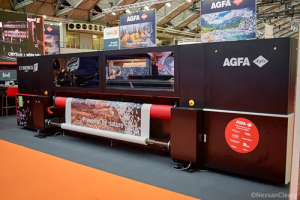
Photo- Nessan Cleary
EFI had a number of new models on its stand, mostly upgraded versions of existing machines. Thus there was a new 3.2-meter wide Pro 33r roll-to-roll LED printer, which is based on the existing Pro 32r+. EFI says that this will deliver up to a 35% speed increase in POP mode, as well as better image quality, thanks to switching to the new 5pL Ricoh Gen6 printheads. It has an integrated mesh kit for printing on porous substrates, a wrinkle analyzer to help avoid printhead strikes, built-in backlit proofing lights, and a built-in Fiery digital front end. It can produce up to 260 sqm per hour.
EFI also showed a new 3.3m wide Q3h hybrid, which is a rebadged version of Agfa’s Tauro and will be sold with the original Agfa inks and Asanti RIP. This is available in two variants, as the X and the slightly more productive XP. There’s a choice of four colors with CMYK or six with the additional light colours as well as optional white and clear inks. It can produce up to 96 boards per hour, equivalent to 905 sqm per hour.
EFI has also upgraded its Vutek H-series hybrid printers with a new H+ specification for both the H3+ and H5+ machines, which is said to offer greater refinements though this was not shown at Fespa. There’s a lot more to say about EF, particularly around the Nozomi platform, I but I don’t think that we can get a fully rounded picture of EFI until Drupa so this part of the story is a work in progress.
That’s not the case with Agfa, which is not going to be at drupa and instead put all of its efforts into Fespa, unveiling three new printers, including the Bronco, which is a 3.3m wide hybrid printer.
Essentially, Agfa has adapted the print engine from its existing Jeti Mira flatbed, which is just 2.7m wide. Thus it uses Ricoh Gen5 printheads with a native 7pL drop size. The final configuration will have 12 heads for the CMYKlclm colors plus another four for the white ink. The heads are arranged in four rows, which should deliver up to 248 sqm per hour. However, for now it only runs the basic configuration of two rows of heads, which has a maximum speed of 100 sqm per hour. Customers will be able to upgrade to the full set of heads when they are available.
In addition, Agfa showed the H3200, a 3.2m wide hybrid that was announced earlier this year but was shown for the first time in Amsterdam. This has now been renamed the Cuervo H3200, in keeping with Agfa’s new theme of using animal names for its printers.
Agfa also had a Jeti Condor RTR5200, which is its rebadged EFI Q5 and is a 5m wide rollfed machine. Naturally, Agfa also showed off its Tauro H3300 UHS, which EFI also showed in its colors. The fourth corner of the Agfa stand went to the Onset X3, complete with a robotic arm for loading and unloading media, and newly renamed as the Grizzly.
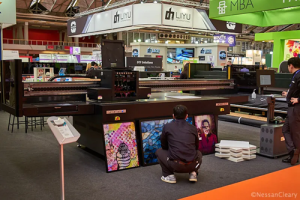
Photo- Nessan Cleary
Inktec has introduced a new UV LED flatbed, the Jetrix LXa5 that’s aimed at entry level users. It has a bed size of 2.5 x 1.3 m. This uses Konica Minolta KM1024a printheads, which is a slightly unusual approach as these are analog heads but Todd Kim of Inktec says: “We think the analog head has better print quality, even compared with the Ricoh Gen5.”
The head has been set up to deliver a binary 6pL drop size, rather than the more usual approach of jetting multiple drop sizes. It offers a maximum resolution of 1440 x 726 dpi.
There are six ink channels with a fairly flexible choice of configurations. This includes CMYK plus either light cyan and light magenta, or two whites or a combination of one white, primer, and clear ink. There’s recirculation for the white ink channels from the main ink tank to the sub-tank but not at the head itself.
It can produce up to 37 sqm per hour in four-pass mode, though this drops to 19 sqm per hour in its higher quality 8-pass mode. It has an anti-crash system to protect print heads. It will take media up to 100 mm thick and pneumatic pin registration for quickly placing media on the table. The LXa5 is available now.
Vanguard Europe, which is a subsidiary of Durst, used the European Fespa show to introduce the VKR3200-HS, which was described as a new 3.2 m wide roll-to-roll large format printer. That’s a bit misleading since Vanguard has been offering exactly the same printer in its main US markets long before Durst acquired the company. So the only new part is that it’s now being manufactured in Europe for the European market. Otherwise, the VKR3200-HS is a 3.2m wide machine fitted with Kyocera KJ4A printheads with a choice of four or eight heads, and able to print CMYK plus light cyan and light magenta as well as white.
Vanguard Europe is essentially a copy of the main Vanguard operation in the US. Thus it manufactures its printers that are destined for the European market at its base in Brixen next to Durst on the Italian side of the Tyrol region. This sort of distributed work demonstrates an environmental-friendly approach to manufacturing as it cuts out a lot of the carbon footprint and therefore waste associated with shipping printers all over the world from a central production hub.
There were also a number of Direct-to-object printers on show. These are mostly flatbeds that can be adjusted to accommodate objects of different heights. Roland DG, for example, introduced a new VersaObject CO-i series of flatbeds for printing to objects up to 242 mm in height and 100 kg/m2 in weight. They are said to be able to print to slightly curved objects such as footballs. There are five models in all, with sizes ranging from 762 mm to 1625 mm wide. Print resolution is up to 1440 dpi, with LED UV curing. There are eight ink channels, with a choice of CMYK plus red and orange with either white, gloss or primer.
Roland also showed off a new small flatbed from its VersaStudio range, the BD-8, which can take objects up to 240 x 1787 mm and 102 mm in height. It can be fitted with an optional rotary axis so as to print onto cylindrical objects. It uses UV LED inks and prints CMYK plus white and a primer which allows it to handle a variety of materials such as glass and metal as well as fabrics, plastics, and wood.
Epson showed off two small devices with A4-sized platens. This included the SureColor V1000, a small UV flatbed printer that’s suitable for producing small items such as fridge magnets or decorating objects like golf balls. It will take objects up to 70 mm high and print to various materials including polycarbonates, aluminum, wood and stone. It’s been designed to fit flush against a wall, with the lid hinged to still allow it to open fully, and a smart squared-off glass casing.
This was matched by the almost identical-looking SureColor F1000, which is Epson’s smallest DtG printer, and which I will cover in the follow-up to this story. The entire stand was pitched as a micro-retail environment, with a countertop fitted around a P65000 photo printer and two small printers at either end. It’s an interesting idea and not hard to see a cafe offering to print souvenirs while customers drink their coffees.
Mutoh brought along its A1-sized flatbed, the XpertJet1462UF, which I previously covered at last year’s Fespa when it was shown as a prototype. It’s commercially available now.
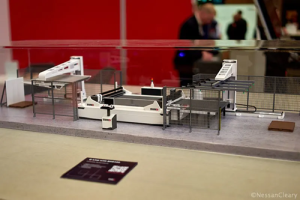
Photo- Nessan Cleary
Another trend that struck me was the sheer number of cutting tables being shown off. It’s not so long ago when this segment would have been limited mainly to Zund and Kongsberg at Fespa. But there are a lot of different players now. Some are established European companies, such as Elitron and Bullmer, but there are also a lot of new Chinese manufacturers, including iEcho and JWEI, who are becoming quite prevalent in the marketplace now.
There is some evidence of a trend toward larger tables, as well as a very noticeable growth in the automation around these tables. This is only to be expected given that both of these trends match similar patterns with large format printers. I expect that this is something that we will see more of at drupa, where there will be more space and time to justify setting up the larger automated cutting tables.
The third part of this story covers the other side of Fespa and the various textile printing solutions that were shown in Amsterdam.




